From The CRPG Addict
United Kingdom
Date Ended: 17 June 2020
Difficulty: Moderate-Hard (3.5/5)
Final Rating: (to come later)
Ranking at time of posting: (to come later)
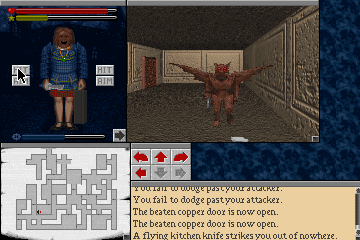 |
| By the end of the game, Irene was wearing a skirt, samurai armor, and a demon mask. |
There is one exception to that statement, and that is in the area of spells. The spellcasting system in The Legacy is so flawed that I can’t believe the developers let it out the door. The basic problem is that they’ve populated the game with about 20 interesting and useful spells, and then they make you paranoid about casting any of them by making spell power a precious resource, reclaimable only (or almost only) through the use of a limited number of magic crystals.
There are times in the game that it seems like you have way too many crystals to ever worry about running out. But then you reach the lower levels of the basement and find a dozen or so magically-locked doors that will only open to “Key of the Shadow Lord”–and not just one successful casting, but sometimes multiple castings at the highest power. There were times that a single door wiped out my entire magic bar. The paltry two crystals that I’d saved “in reserve” turned out to be laughably inadequate when I started encountering these doors. Soon, I was wishing that I had never cast a single spell the rest of the game–that I had saved all my energy for those damned doors, and all my experience for improving my skill with the spell. When I ended the game, I didn’t have a single crystal remaining–that’s how close I came to not being able to win at all, despite your warnings and despite playing (I thought) conservatively with magic.
The annoying thing is that there are some great spells, offensive and defensive, that would have been useful throughout the game. A few tweaks would have created an adventure game with an excellent RPG-style magic system, such as allowing spell points to regenerate over time, or allowing the character to rest more often to recover both health and spell points. Instead, they made a game that would put a large percentage of players in a “walking dead” situation in the last tenth of the game.
The resting system is so bizarre, in fact, that I think it must be bugged. In 25 hours of gameplay, I only got explicitly tired once, and was only able to rest twice. It’s like there was no difference between game time and real time. Similarly bugged is the food system: I was able to eat maybe four or five times, leaving a dozen or so unopened food items. I didn’t particularly want to have to eat more often (especially since food is finite), but resting is a key method of health and mana recovery in most RPGs, and a true hybrid would have been more lenient.
The story didn’t develop a lot from the summary I gave last time. The builder of the house, Elias Winthrop, made a deal with the dark god Belthegor to bind his family to service. Over the centuries, descendants of Elias, mad or evil, expanded on the house, made deals with lesser gods allied with Belthegor, and ensured Belthegor’s return to the material plane every 50 years. This event was meant to be special, with the last descendants of Winthrop’s slated for sacrifice so that Belthegor could enter the plane permanently.
 |
| The areas of The Legacy |
The game ultimately consisted of ten 20 x 20 areas, a reasonably sized “dungeon” even for an RPG. You have a lot of latitude in the order of exploration, and given that you find items in all areas useful in others, I don’t suppose there’s a single “right” order except probably to clear the ground floor and upper floor first. In short:
- The Ground Floor introduces you to the game and its conventions, including your first crude weapons. Zombies roam the corridors; they’re easy to kill, and you find a fetish that allows you to walk past them with impunity.
- The Upper Floor starts to deliver more information about the setting and its story. The area is crawling with ghosts, who can be addressed individually or en masse through the burning of the painting that binds them.
- The third floor is somewhat nonsensically an Asylum with sterile hallways and padded cells. You encounter a lot more trouble with locked and secret doors on the level, which is prowled by blobs of fire, giant floating two-headed leeches, and an insane relative in a straitjacket.
- The fourth floor is a Museum (though not public) of powerful artifacts. You learn here the rituals that you need to banish the dark gods, and you acquire some of your most powerful equipment. There are many puzzles that must be solved by returning plaques and items strewn about the mansion to their proper places in the museum. Enemies are floor slimes (almost impossible to step around) and these disgusting crab things, the latter of which can be destroyed en masse with a ritual involving statues.
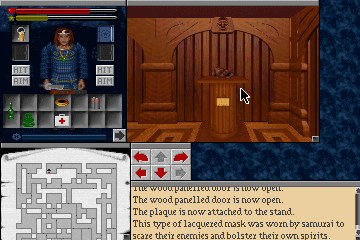 |
| Returning plaques to the museum pedestals allowed me to take items on those pedestals. |
- The Mausoleum is full of secret doors and has the bodies of former residents of the house, most alive and animated as skeletons. Kill one, and it rises again the next time you trespass on its bones unless you use “coffin dust” (which is in limited supply) to destroy it permanently. You have to kill all the enemies to get the Golden Torc, an artifact necessary to win the game.
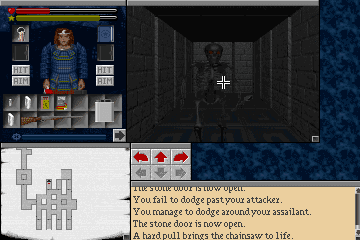 |
| Cutting into a skeleton with a chainsaw. |
- The Egyptian Tomb is full of magically-locked doors. The primary goal is to summon and destroy the Karcist–the transformed spirit of the house’s builder, Elias Winthrop. You have to fight your way through “sonic mummies,” capable of damaging you even through doors. You have to summon the Karcist with the “Chinese Coins” you find on the Asylum level, and once summoned, you can kill him in regular combat or by first finding his heart and destroying it in front of him.
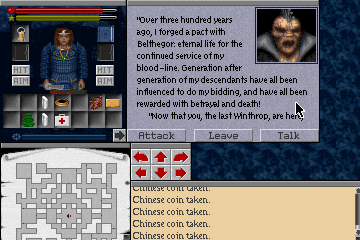 |
| Old Elias changed his tune quickly once I showed him his heart. |
- The Basement has a variety of demons and supplies you with information and weapons necessary for the lower levels. One important chamber lets you create an artifact necessary for the final level.
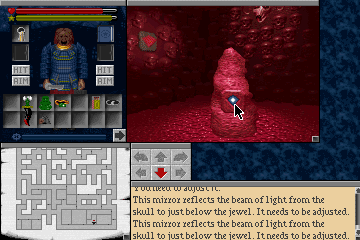 |
| Making the Eye of Agala in a basement room. |
- The corridors of the Sub-Basement are patrolled by the dark god Alberoth. You have to use an astrolabe (from the museum) in an observatory in the Egyptian tomb to banish him. There are also burrowing worm creatures to kill.
- The Sea Demon Caves are the home to walking fish creatures that demand human sacrifices, and their humanoid “servitors.” You have to get past the dark jellyfish god Melchior (I don’t believe you can kill him, but you can get him to ignore you with the Golden Torc). There are a number of teleporters, including an annoying one that takes you all the way back to the ground floor, but ultimately you find the exit to the Astral Plane and the final battle.
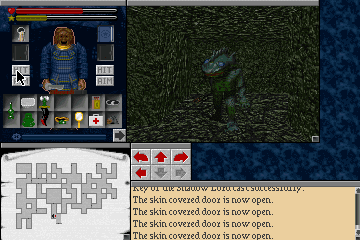 |
| One of the sea demons, which hopefully you can see better than I can. |
It’s notable that the game gives you several approaches for conquering each level. I adopted a more classic RPG approach and insisted on killing every enemy that could be killed, and this wasn’t much of a problem after the first half of the game. I ultimately exhausted the ammunition for most of the firearms, but on a lower level, I found a chainsaw that never seemed to run out of gas (I was mindful to turn it off after each combat, which helped)–and there are three or four gas cans in the game. The chainsaw got me through almost the entirety of the mausoleum and museum. I then followed some instructions in the museum to perform a ritual that made the ancient spirit of a samurai appear and embed his two swords with magic. His katana served me the rest of the game; few enemies survived more than two hits with it. On the same level, I also found a suit of samurai armor that served as my primary protection from then on, plus a demon mask that made me look like a lunatic but also strengthened my attacks.
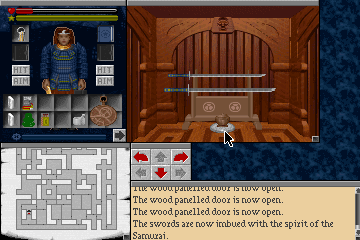 |
| A little ritual provides the best weapons in the game. |
But the game also gives you a way around most enemies. Sometimes, they can simply be avoided, as in the sonic mummies, which will leave you alone if you find and carry the “boom box” (remember those?). Sometimes, there’s a puzzle you can solve to destroy them all at once, and sometimes there’s a weapon to which they are uniquely vulnerable. For instance, the worms in the sub-basement die quickly from blasts of rock salt from a modified shotgun. But by the time I reached this area, my katana was cleaving through everything so nicely that I barely bothered.
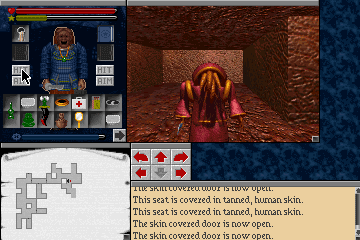 |
| Instead of fighting this servitor, I can make myself look like him by wearing his robes and putting a squid on my head (seriously). |
While you get some experience for killing individual monsters, you get more from solving puzzles, so the game doesn’t encourage you along an RPG mindset.
I misunderstood the nature of the Ethereal Plane until almost the end of the game. While I’d been seeing doors to it throughout the house–and you can open more by casting “Dimensional Portal” wherever you see a glyph on the wall–I wasn’t sure what its purpose was. I wasn’t even sure that all the portals went to the same place. I assumed it was some place I’d have to visit for a penultimate or ultimate showdown. Instead–although it has some monsters and one NPC–it’s more a method of fast travel around the game. If you take time to map the exits (which look like cubes), you can quickly get from, say, the sub-basement to the museum without having to find all the stairways. I was only an hour from winning when I realized how the plane worked and I thus missed its benefits for most of the game.
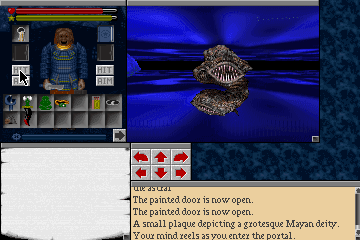 |
| The Ethereal Plane with one of its monsters and a portal to its left. |
A few notable encounters and puzzles:
- A “Magician of the Right Hand Path” named Charles Wenlock approached me in the Ethereal Plane. His “inner self” had been trapped there, and he needed to draw on my energies to escape. I said yes, even though I didn’t exactly have a surplus of magic power. In return, he gave me some advice for surviving the Astral Plane and the final confrontation with Belthegor, plus a spell. The spell was automatically “implanted in my mind,” so I didn’t notice which one it was.
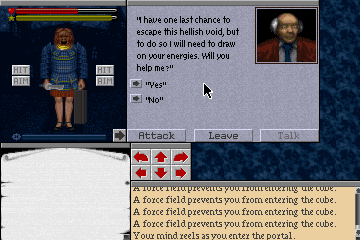 |
| One of the few “role playing” choices in the game. |
- In the Sea Demon caves, there was some kind of altar on which a stone was surrounded by a glass shield. Fiddling with the shield produced a message that it resonated with a particular note. This was a clue to use a flute that I’d previously found to play the same note, shattering the glass. It was still difficult to take the stone; electric tendrils going up and down two columns zapped me if I didn’t time it just right.
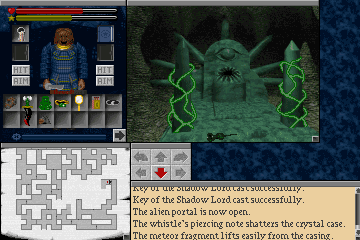 |
| Something feels Lovecraftian about this level. |
- A juicy diary entry indicated that Josiah Maitland (grandson of Elias Winthrop) was poisoned by his wife for somehow “tricking [her] into marriage vows.”
- A note indicated that an entire Boston Police squad was killed when they tried to investigate the sea demon caves in the 1920s.
The final confrontation takes place on the Astral Plane. Fire blobs are back, and you probably don’t have a fire extinguisher by this point. Even worse, teleportation cubes roam the hallways and transport you to other levels if they hit you. There are also energy barriers that require an artifact called the Eye of Agala, which you have to make in a ritual in the basement. Finally, Belthegor himself is behind an illusory wall. My magic was so low that I couldn’t explore the entire level. I had to take a save at the beginning and keep staking out in different directions, reloading if I didn’t find anything interesting, until I finally found the way to Belthegor.
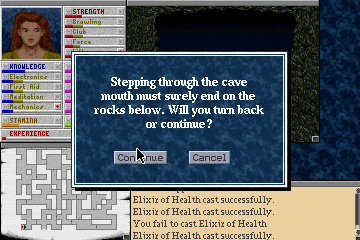 |
| From the Sea Demons’ caves to the Astral Plain. |
Belthegor can kill you instantly if you don’t have the Golden Torc from the mausoleum. Even with it, you want to load up on all the magic resistance items and spells that you have before you enter. I don’t know if he’s immune to regular weapons or just extremely resistant, but I was only able to kill him with spells. Fortunately, the final battle is otherwise easy because your mana bar suddenly becomes inexhaustible. You just need to keep casting offensive spells (I alternated “Flames of Desolation” and “Obsidian Shards of Annihilation,” which is perhaps the greatest spell name ever) and pound away at “Elixir of Health” if your health gets low.
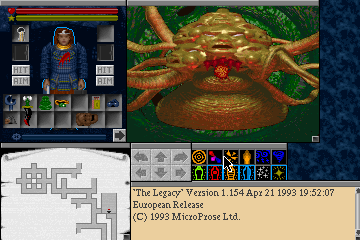 |
| I ended up fighting Belthegor three times because the game kept crashing during the final cinematic. This was the easiest of the battles. I didn’t even have to cast “Elixir of Health” once. |
Once Belthegor is defeated, a brief cinematic brings the game to a close. A storm gathers over the mansion, and its ghosts are freed or sucked up into it, depending on your interpretation.
 |
| This is the brightest shot I could capture. |
 |
| I think that’s a little unfair to the police. It’s not their responsibility to explain the noncriminal destruction of property. |
- 6 points for the game world, perhaps the best part of the game. The mansion is suitably creepy, the backstory (while a bit derivative) suitably detailed. I like the way that you slowly learn the mansion’s history through scraps of notes, diary pages, letters, and so on.
 |
| The game’s epistolary revelations never get old. |
- 4 points for character creation and development. The mechanics are sound. I like that you can choose among multiple defined characters or create your own. I like that you can spend your experience directly on skills. I don’t like that the latter stages of the game require magic and thus punish you for not having invested heavily there, nor that development in other skills isn’t well-reflected in the game. This is not Quest for Glory, where you can choose your strength and role-play that type of character. With just a few tweaks, it could have been.
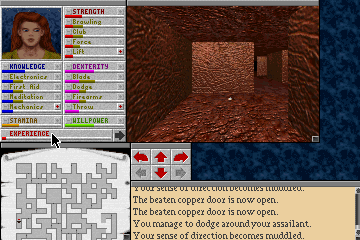 |
| Irene’s skills at the end of the game. Very few reached 50% on their bars and a couple never did anything. |
- 4 points for NPC interaction. Again, the mechanics are good, and I appreciated the dialogue options, but there are only a few people with whom you can interact.
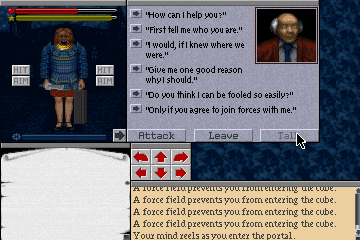 |
| Dialogue options with an explorer in the Ethereal Plane. |
- 6 points for encounters and foes. This was another strong part of the game. I particularly liked that you could intuit the solution to most puzzles, but if you had trouble, some document or NPC dialogue would eventually spell it out for you. The puzzles were varied and fun, though not as much as some other adventure games I’ve enjoyed. The monsters are well-chosen for the setting and have their own strengths and weaknesses you have to figure out.
- 3 points for magic and combat. Combat is nothing special–hit or aim. The magic system could have been special if it hadn’t been so suppressed by the game’s miserly approach to magic points.
 |
| Slashing mummies on the Egyptian Tomb level. |
- 3 points for equipment. Most of it is puzzle-solving. You get two pieces of armor, a couple of magic upgrades, and far too many possibilities for weapons. I would have preferred the game content itself with one firearm than to lead so much specialized ammunition scattered around.
- 0 points for no economy.
- 3 points for a main quest with some side areas.
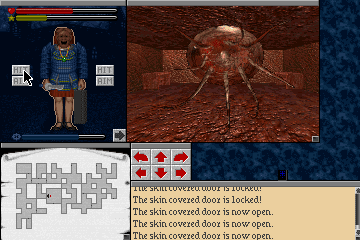 |
| Attacked by the dark god Melchior. |
- 5 points for graphics, sound, and interface. It gets almost all of those for graphics (good enough for what the game was trying to achieve) and sound, including (though I rarely rate it) a decent music score that accompanies the game rather than overwhelming it. The interface was mostly awful. Half the time you go to click on something, the game either ignores you or clicks on something else. The act of putting down a gun and equipping a spellbook sometimes took several minutes of fruitless clicking, often while an enemy was attacking. The limited inventory discourages carrying alternatives to most weapons or armor. Ideas like “document wallets” are only good if there’s enough space for all your documents. Having movable/resizable windows isn’t a bad idea, though I didn’t make much use of it. Really all I liked from the interface was the automap.
- 5 points for gameplay. It’s about as nonlinear as a game with “levels” could be. As with most adventure games, I’m vaguely curious to play it a second time as a speed run, but otherwise I don’t see it offering rewards for a second pass. The challenge level (aside from the magic thing) and length were just about right.
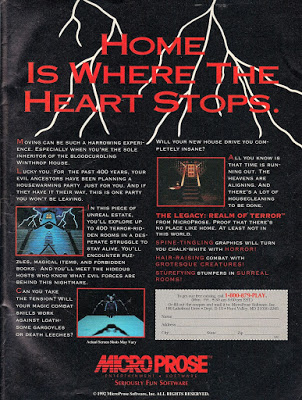 |
| There is nothing corresponding to that lower screen capture in the game. |
Original URL: http://crpgaddict.blogspot.com/2020/06/the-legacy-won-with-summary-and-rating.html

